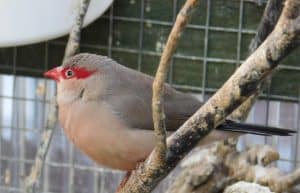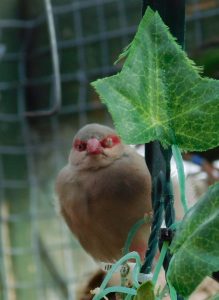As a rule, waxbills are interesting little birds to keep as they are very busy, always doing something and good entertainment. The red eared waxbill is one of the smaller members of this branch of the Estrildid family tree and is every bit as lively and interesting as its slightly bigger cousins. Here is a glimpse into the species.
In the wild
The red eared waxbill is also known as the black rumped waxbill, the Senegal waxbill and has the Latin name Estrilda troglodytes. In the wild, this bird is found from Senegal and Gambia through north-eastern parts of Congo, north-west Uganda and the northern part of Sudan. It extends into Eritrea and north-western areas of Ethiopia.
The natural habitat of this species includes dry steppes areas well as semi-arid spots with thorn scrub, open grassland and woodland areas. They sometimes live alongside rivers, marshes and swamps.
Description of the red eared waxbill
 The red eared waxbill is often mixed up with its close cousin, the Common Waxbill or St Helena. Both bird have red eye stripes, similar buff coloured body feathers and red beaks. The main way to tell the difference is that the Common waxbill has stronger bar markings on the feathers, has a brown rump and doesn’t have any white tail feathers whereas the Red eared waxbill has a fine white tail feather lining. The Common waxbill also has a crimson stripe down the middle of the breast and on to the belly.
The red eared waxbill is often mixed up with its close cousin, the Common Waxbill or St Helena. Both bird have red eye stripes, similar buff coloured body feathers and red beaks. The main way to tell the difference is that the Common waxbill has stronger bar markings on the feathers, has a brown rump and doesn’t have any white tail feathers whereas the Red eared waxbill has a fine white tail feather lining. The Common waxbill also has a crimson stripe down the middle of the breast and on to the belly.
Mutations do exist although aren’t that common in the UK. These include a yellow billed mutation where all the red on the bird turns yellow and a fawn mutation where the markings turn from black to brown while the red remains the same. A pied mutation involves random patches of white across the body.
These birds mix well with others in an aviary but can cross with other closely related species, particularly the Common waxbill, so care needs to be taken to avoid this.
In captivity
One of the first things to remember about these birds is where they originally came from – central Africa. This means they are finely feathered and cannot withstand our climate in the UK without help. This means heating during the winter, protection from the weather or being kept indoors. Cold weather can also increase the chance of hens becoming egg bound.
A good foreign finch or special waxbill seed mix is a solid basis for their diet. They will take some fresh vegetables and greens, sometimes fruit, much depending on what they have been offered as young birds. Millet spray will also be enjoyed as will soaked or sprouted seeds.
Live food is crucial for breeding and this includes small mealworms or waxworms, crickets, locusts, ant pupae or fruit flies.
Breeding the red eared waxbill

Most breeders recommend that a breeding diet with live food should be introduced around one month before breeding including soaked or sprouted seed, egg food and greens. The best age to breed birds is from 1 to 3 years.
Often, these birds build their nests near to the ground or in the bases of bushes. They don’t often use nest boxes but they can be offered just in case. The nest will often include a ‘cocks nest’ on the top or side and they will decorate it with feathers and any white or shiny objects they see, such as bits of egg shell. These decorations are most common in the cock’s nest and may be a decoy to attract predator attention.
There are 3-6 eggs laid and are incubated for around 12 days. The young fledge at 21 days and return to the nest at night for the first few evenings before then roosting away from it. They are weaned at around four weeks and have their juvenile moult at around eight weeks old.